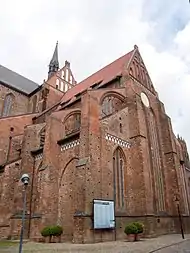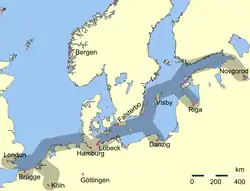Wismar
Wismar (German pronunciation: [ˈvɪsmaʁ]) is a port and Hanseatic city in Northern Germany, located on the Baltic Sea in the state of Mecklenburg-Vorpommern about 45 km (28 mi) east of Lübeck and 30 km (19 mi) north of Schwerin. Its natural harbour, located in the Bay of Wismar is protected by a promontory. As part of the Hamburg Metropolitan Region, in 2013 Wismar had a population of 42,219 inhabitants. It is the capital of the district of Nordwestmecklenburg.
Wismar | |
|---|---|
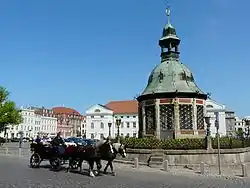 Market Square with the waterworks from 1602 (Wasserkunst), landmark of Wismar | |
 Coat of arms | |
Location of Wismar within Nordwestmecklenburg district  | |
 Wismar 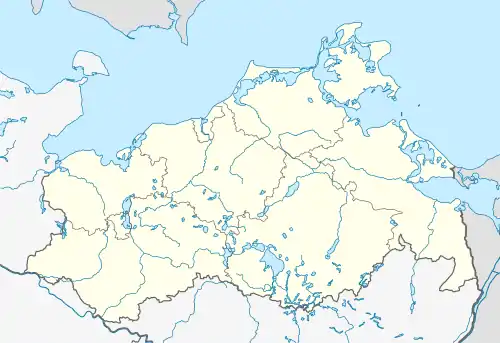 Wismar | |
| Coordinates: 53°54′N 11°28′E | |
| Country | Germany |
| State | Mecklenburg-Vorpommern |
| District | Nordwestmecklenburg |
| Government | |
| • Mayor | Thomas Beyer (SPD) |
| Area | |
| • Total | 41.36 km2 (15.97 sq mi) |
| Elevation | 15 m (49 ft) |
| Population (2019-12-31)[1] | |
| • Total | 42,963 |
| • Density | 1,000/km2 (2,700/sq mi) |
| Time zone | UTC+01:00 (CET) |
| • Summer (DST) | UTC+02:00 (CEST) |
| Postal codes | 23952, 23966, 23968, 23970 |
| Dialling codes | 03841 |
| Vehicle registration | HWI |
| Website | www |
Situated in the historical region of Mecklenburg, Wismar was founded in the late 12th century or early 13th century. Throughout its history, the city has been under control of various German states as well as the Swedish Empire. It became part of the German Empire in 1871, although Sweden officially renounced its claims to the city only in 1903. Wismar is a typical representative of the Hanseatic League city with its city-wide Brick Gothic structures and iconic gabled patrician houses and has alongside the historical old town of Stralsund been declared a UNESCO World Heritage Sites site in 2002.
History
.jpg.webp)
| UNESCO World Heritage Site | |
|---|---|
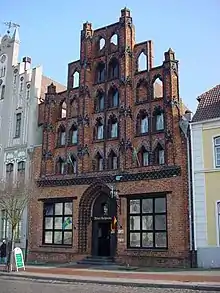 Alter Schwede, c. 1380 | |
| Part of | Historic Centres of Stralsund and Wismar |
| Criteria | Cultural: ii, iv |
| Reference | 1067-002 |
| Inscription | 2002 (26th session) |
| Area | 88 ha |
| Buffer zone | 108 ha |
The name of the settlement was first recorded in the 12th century and is of Slavic origin. It comes from a personal Slavic name Wyszemir.[2] Wismar was part of the Western Slavic Obotrites' territory.
The exact date of the city's foundation is not clear. In the oldest existing document of Wismar of 1229 its civic rights are already established. In 1301 Wismar came under the rule of the House of Mecklenburg.[3] In 1259 Wismar joined a defensive agreement with Lübeck and Rostock, in order to effectively counter the numerous Baltic pirates. Subsequently more cities of the northern Holy Roman Empire would agree to cooperate as commerce and trade was increasingly coordinated and regulated. These policies would provide the basis for the developmemt of the Hanseatic League. By the 13th and 14th centuries Wismar had grown into a flourishing Hanseatic trading hub and important center of wool processing. Although around 2,000 of its inhabitants perished during the plague of 1376, the town remained reasonably prosperous until the 16th century.[4][5]
Under Swedish rule
With the Peace of Westphalia of 1648 Wismar came under the territorial control of Sweden. Through the acquisition of Wismar and other dominions in the Holy Roman Empire, the Swedish monarchs in their role as imperial princes were entitled to a seat in the Imperial Diet. Wismar became administrative center of Wismar town, the districts of Pod and Neukloster and since 1653 the Fürstenhof (prince's court) served as the seat of the supreme court for all Swedish dominions in the Holy Roman Empire. Wismar's fortifications were extended into an effective all-round defence system under the supervision of Field Marshal Erik Dahlbergh. Remains of these fortifications have been preserved, among other places, in the ‘Lindengarten' to the east of the wall of the old city.[6][7]
In 1803, Sweden ceded both the town and lordship to the Grand Duchy of Mecklenburg-Schwerin for a sum of 1,258,000 Riksdaler, who had, however, reserved the right of redemption after 100 years. In view of this contingent right of Sweden, Wismar was not represented at the diet of Mecklenburg-Schwerin until 1897. In 1903, Sweden finally renounced its claims to the town. Wismar still retains a few relics of its old privileges, including the right to fly its own flag.[4][8][9]
20th century
By the end of the 19th century Wismar's most important manufacturing branches were the production of iron & steel, roofing-felt, asphalt, paper and machine industry. International sea trade took place at the local harbour, which was deep enough to admit vessels of up to 5 m (16 ft) draught at its quays. Exports included grains, oil-seeds and butter as coal, timber and iron was imported.[4] Wismar was production site for several railroad rolling stock manufacturers and since 1933 home to Norddeutsche Dornier-Werke of aircraft manufacturer Dornier.[10] On 14 May 1881 Rudolph Karstadt opened his first shop (Tuch-, Manufaktur- und Konfektionsgeschäft) of the now well established department store chain Karstadt in Wismar.[11]
In World War II Wismar was heavily bombed and destroyed by Allied air raids. As the line of contact between Soviet and other Allied armies formed in Europe at the end of the war, Wismar was captured by the British 6th Airborne Division's 1st Canadian Parachute Battalion on 2 May 1945.[12] On 7 May 1945 British Field Marshal Montgomery and Soviet Marshal Konstantin Rokossovsky met in Wismar. In accord with the Occupation Zone Agreements of the Yalta Conference Wismar became a part of the Soviet Occupation Zone of Germany on 1 July 1945, as British troops retreated and Soviet troops took control over the area.
During the 1949 to 1990 era of the German Democratic Republic, Wismar became East Germany's second-largest port, after Rostock and developed a shipbuilding industry. Although the GDR government had pledged to restore the local churches and historic sites that had been heavily bombed during the war, this commitment was for the most part not fulfilled.
After German reunification in 1990, churches and all historic buildings in the city's town center were restored, and the old towns of Wismar and Stralsund (ca. 110 km (68 mi) to the east), were listed as UNESCO world heritage sites. In 2011, Wismar became the capital of the district of Nordwestmecklenburg.[13]
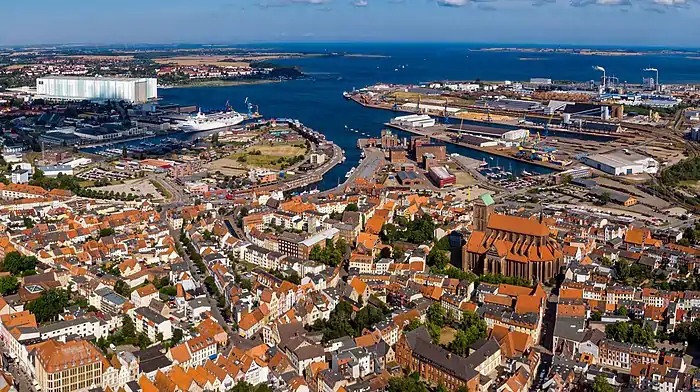
Mayors and Lord Mayors
- 1919–1929: Lawyer Hans Rasp (1877–1957, SPD)
- 1929–1933: Heinrich Brechling (1897–1959, SPD)
- 1933–1945: Alfred Pleuger (NSDAP)
- May 1945 – June 1945: Heinrich von Biel (independent)
- June 1945 – August 1945: Heinz Adolf Janert (1897–1973) (independent)
- August 1945 – 1945: Karl Keuscher (KPD)
- September 1945 – 1945: August Wilke (KPD)
- December 1945 – December 1950: Herbert Säverin (1906–1987) (SPD/SED)
- January 1951 – June 1952 Erhard Holweger (1911–1976) (SED)
- August 1953 – June 1957: Herbert Kolm (SED)
- July 1957 – April 1969: Herbert Fiegert (SED)
- April 1969 – November 1989: Günter Lunow (born 1926) (SED)
- November 1989 – May 1990: Wolfram Flemming (SED), temporary
- 1990–2010: Rosemarie Wilcken (born 1947) (SPD)
- since July 2010: Thomas Beyer (born 1960) (SPD)
Sights & architecture
The historical old town, centred by the huge market place (one of the largest in northern Germany, 10,000 m2 (110,000 sq ft)), is characterized by town houses, manufacture and trading structures of the Hanseatic League, built in Brick Gothic style during the 13th to 15th centuries, 19th-century Romanesque Revival architecture and Art Nouveau houses. Distinctive buildings and military works, built during the period of Swedish control during the 17th and the 18th centuries provide another layer of cultural influence.
The market square's focal point is the Wasserkunst, an elaborate wrought-iron fountain imported from Holland in 1602. The northern side of the square is occupied by the Town Hall, built in Neoclassical style from 1817 to 1819. Another notable building on the square is a Brick Gothic patrician's home (Bürgerhaus) called Alter Schwede (Old Swede), erected around 1380.
St. George's Church, the third so-named edifice on the site, dates from 1404. It had escaped major damage during most of World War II, but on 14 April 1945, three weeks before the end of the war it was badly damaged by "Blockbuster bombs" dropped by the British Royal Air Force. Reconstruction after German reunification, costing some 40 million Euros, was completed in 2010.
The 80 m (260 ft)) high tower church of St. Mary's Church (Marienkirche) is the only remainder of the original Brick Gothic edifice, built during the first half of the 13th century. It suffered heavy damage in World War II, and was partially razed in 1960 during the East German era.
St. Mary's Church and the church of St. Nicholas (Nikolaikirche) with its very lofty vaulting, built from 1381 to 1460, serve as prime examples of Lübeck's St. Mary's Churches architectural influence on the entire region.[4]
The Fürstenhof, a richly decorated specimen of early Italian Renaissance style was once a ducal residence and served later as the seat of the municipal authorities. Built from 1552 to 1565, it was restored from 1877 to 1879. The Old School, dating from about 1300, has also been restored. The town hall, rebuilt in 1829, houses a gallery of paintings.[4] The Fine Arts Municipal Gallery Baumhaus is located in the old harbour area.
Economy
Nordic Yards Wismar is a shipbuilder located in Wismar and shipbuilding has existed since 1946 at the site.
Notable people from Wismar
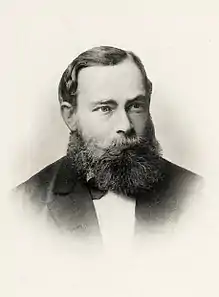

- Klaus Störtebeker (c. 1360–1401), privateer
- Sophie of Mecklenburg-Güstrow (1557–1631), queen of Denmark
- Bernhard Latomus (1560–1613), historian
- Daniel Georg Morhof (1639–1691), historian
- Joachim Gerstenbüttel (c. 1650–1721), composer
- Johan Henrik Scheffel (1690–1781), Swedish painter
- Johan Carl Wilcke (1732–1796), physicist.
- Friedrich Christoph Dahlmann (1785–1860), historian, statesman
- Heinrich Keil (1822–1894), philologist
- Theodor Martens (1822–1884), architectural and landscape painter
- Friedrich Bernhard Christian Maassen (1823–1900), law professor
- Gottlob Frege (1848–1925), mathematician, logician and philosopher
- Marie Musaeus Higgins (1855–1926), founder of Musaeus College, Colombo
- Franz Ziehl (1857–1926), a bacteriologist
- Gustav Neckel (1878–1940), Germanist and Skandinavist
- Anton von Hohberg und Buchwald (1885–1934), Reichswehr and SS officer
- Harald Weinrich (born 1927), German classical scholar; scholar of Romance philology and philosopher; emeritus professor of the Collège de France, where he held the chair of Romance literature from 1992 to 1998
- Heino Kleiminger (1939–2015), football player
- Gunter Pleuger (born 1941), diplomat and politician
- Klaus Grünberg (born 1941), actor
- Peter Sykora (born 1946), soccer player of the GDR
- Joachim Streich (born 1951), football player and coach
- Marita Koch (born 1957), track and field athlete of the GDR and Olympic champion
- Roswitha Eberl (born 1958), canoeist
- Kerstin Brandt (born 1961), high jumper
- Andreas Zachhuber (born 1962), football player and coach
- Kathrin Haacker (born 1967), Olympic champion in rowing
- Fiete Sykora (born 1982), football player
- Robert Tesche (born 1987), football player
Wismar in art and literature
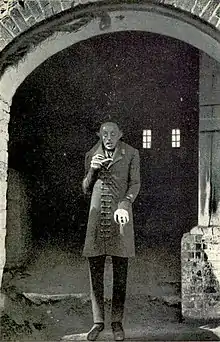
- Wismar (renamed "Wisborg") was the setting of the 1922 silent film Nosferatu, eine Symphonie des Grauens (Nosferatu: A Symphony of Horror). This German Expressionist horror film, directed by F. W. Murnau and starring Max Schreck as the vampire Count Orlok, was partly shot in Wismar. Filming began in July 1921, with exterior shots in Wismar. A take from the Marienkirche's (Saint Mary's Church) tower over Wismar marketplace with the Wasserkunst Wismar (waterworks fountain) served as the establishing shot for the Wisborg scene. Other locations included the Wassertor (Water Gate), the southside of St. Nicholas, the Heilig-Geist-Kirche (Holy-Spirit-Church) and the harbour area.
- Wismar was also the setting of Werner Herzog's 1979 remake Nosferatu, Phantom der Nacht. However, Herzog unable to film in Wismar, relocated his production to the cities of Delft and Schiedam in the Netherlands. The 2000 metafiction horror film Shadow of the Vampire, directed by E. Elias Merhige which depicts the filming of the 1922 silent movie also takes place in Wismar.
International relations
See also
- State Museum of Technology outside of Wismar.
References
- "Statistisches Amt M-V – Bevölkerungsstand der Kreise, Ämter und Gemeinden 2019". Statistisches Amt Mecklenburg-Vorpommern (in German). July 2020.
- Słownik starożytności słowiańskich, vol. VI, part II, Wrocław 1980, p. 657.
- Friedrich Crull (1875). Die Rathslinie der Stadt Wismar- p. XVII ff. Buchhandlung des Waisenhauses.
-
 One or more of the preceding sentences incorporates text from a publication now in the public domain: Chisholm, Hugh, ed. (1911). "Wismar". Encyclopædia Britannica. 28 (11th ed.). Cambridge University Press. p. 754.
One or more of the preceding sentences incorporates text from a publication now in the public domain: Chisholm, Hugh, ed. (1911). "Wismar". Encyclopædia Britannica. 28 (11th ed.). Cambridge University Press. p. 754. - Franz Schildt (1871). Geschichte der Stadt Wismar bis zum ende des 13. jahrhunderts. E. Kuhn. pp. 83–.
- Dumrath 1911, p. 203.
- "Swedish era - Zwei Städte - Ein Erbe". Wismar-stralsund.de. Archived from the original on 2 February 2014. Retrieved 5 January 2021.
- Philip Tober (2007). Wismar im Dreißigjährigen Krieg 1627 - 1648: Untersuchungen zur Wirtschafts-, Bau- und Sozialgeschichte. LIT Verlag Münster. pp. 53–. ISBN 978-3-8258-0101-4.
- Gerd Giese (2001). Wismar: Portrait einer Stadt. Sutton Verlag GmbH. pp. 67–. ISBN 978-3-89702-370-3.
- "Flugzeugbau in Wismar - Die Norddeutschen Dornierwerke". Wismar De. Retrieved 4 January 2021.
- "14. Mai 2006 - Vor 125 Jahren: Rudolph Karstadt eröffnet sein erstes Geschäft". Westdeutscher Rundfunk (in German). Retrieved 6 January 2021.
- "HyperWar: The Last Offensive Chapter XIX Goetterdaemmerung". Ibiblio. Retrieved 4 January 2021.
- Sven Abrokat (1997). Politischer Umbruch und Neubeginn in Wismar von 1989 bis 1990. Krämer. ISBN 978-3-89622-016-5.
- "Website des Förderkreises St. Georgen zu Wismar e.V." georgenkirche.de. Retrieved 22 March 2018.
- "Städtepartnerschaften". wismar.de (in German). Wismar. Retrieved 2 December 2019.
 This article incorporates text from a publication now in the public domain: Dumrath, Oskar Henrik (1911). "Sweden". In Chisholm, Hugh (ed.). Encyclopædia Britannica. 26 (11th ed.). Cambridge University Press. pp. 188–221.
This article incorporates text from a publication now in the public domain: Dumrath, Oskar Henrik (1911). "Sweden". In Chisholm, Hugh (ed.). Encyclopædia Britannica. 26 (11th ed.). Cambridge University Press. pp. 188–221.
External links
- Centres of Stralsund and Wismar: UNESCO Official Website
- Official site
- Wismar City Panoramas – Panoramic Views and Virtual Tours
- Hochschule Wismar, University of Technology, Business and Design
- Unesco World Heritage Wismar
- Evangelische Kirchengemeinden in Wismar
- Website mit historischen Bildern von Wismar
- 17th-century account on the City
